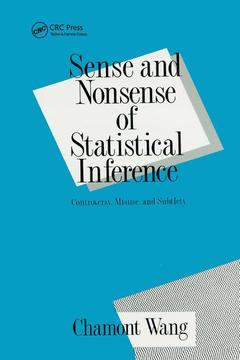Sense and Nonsense of Statistical Inference Controversy: Misuse, and Subtlety Popular Statistics Series
Auteur : Wang Charmont

Date de parution : 09-2019
15.6x23.4 cm
Thèmes de Sense and Nonsense of Statistical Inference :
Mots-clés :
Statistics Users; Statistical Inference; statistical causality; QC Circle; Soft Sciences; hypothesis testings; Non-experimental Sciences; Rubin's model; National Academy; quasi-Inferential statistics; Regression Model; Vice Versa; Heart Rate Time Series; QC Expert; Yule’s Model; Held; Strong Ignorability; Parkinson’s Disease; Rubin’s Model; Kolmogorov Extension Theorem; Androgyny Research; Neyman Pearson Theory; Trenton Times; Statistical Decision Theory; Dose Response Models; College GPA; Hite Report; GPA; High Exposure Period



